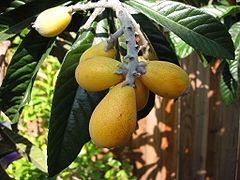Loquat
| Loquat | |
|---|---|

| |
| Loquat fruit approaching maturity | |
| Scientific classification | |
| Kingdom: | |
| Division: | |
| Class: | |
| Order: | |
| Family: | |
| Subfamily: | |
| Genus: | |
| Species: | E. japonica
|
| Binomial name | |
| Eriobotrya japonica | |
| Synonyms | |
|
Mespilus japonica | |
The loquat (Eriobotrya japonica) is a fruit tree in the subfamily Maloideae of the family Rosaceae, indigenous to southeastern China.
Description
It is an evergreen large shrub or small tree, with a rounded crown, short trunk and woolly new twigs. The tree can grow to 5-10 m tall, but is often smaller, about 3-4 m.
The leaves are alternate, simple, 10-25 cm long, dark green, tough and leathery in texture, with a serrated margin, and densely velvety-hairy below with thick yellow-brown pubescence; the young leaves are also densely pubescent above, but this soon rubs off.
Loquats are unusual among fruit trees in that the flowers appear in the autumn or early winter, and the fruits are ripe in late winter or early spring. In Northern California, loquats bear fruit in May, while in Southern California, loquats bear fruit in April. The flowers are 2 cm diameter, white, with five petals, and produced in stiff panicles of three to ten flowers. The flowers have a sweet, heady aroma that can be smelled from a distance.
Loquat fruits, growing in clusters, are oval, rounded or pear-shaped, 3-5 cm long, with a smooth or downy, yellow or orange, sometimes red-blushed skin. The succulent, tangy flesh is white, yellow or orange and sweet to subacid or acid, depending on the cultivar. Each fruit contains five ovules, of which three to five mature into large brown seeds. The skin, though thin, can be peeled off manually if the fruit is ripe.

The fruits are the sweetest when soft and yellow.
Use
The loquat is comparable with the apricot in many aspects, with a high sugar, acid and pectin content. It is eaten as a fresh fruit and mixes well with other fruits in fresh fruit salads or fruit cups. Firm, slightly immature fruits are best for making pies or tarts. The fruits are also commonly used to make jam, jelly, and chutney, and are delicious poached in light syrup.
A type of loquat syrup is used in Chinese medicine for soothing the throat like a cough drop. Combined with other ingredients and known as pipa gao (枇杷膏; pinyin: pípágāo; literally "loquat paste"), it acts as a demulcent and an expectorant, as well as to soothe the digestive and respiratory systems. Loquats can also be used to make wine.
Like most related plants, the seeds (pips) and young leaves of the plant are slightly poisonous, containing small amounts of cyanogenetic glycocides which release cyanide when digested, though the low concentration and bitter flavour normally prevents enough being eaten to cause harm.
History

The Loquat is a fruit of Southeastern Chinese origin. It was introduced into Japan and became naturalised there in very early times, and has been cultivated there for over 1,000 years. It has also become naturalised in India and many other areas. Chinese immigrants are presumed to have carried the loquat to Hawaii.
The Loquat was often mentioned in ancient Chinese literature, such as the poems of Li Bai.
Eaten in quantity, loquats have a noticeable but gentle sedative effect, with effects lasting up to 24 hours.
Production
Japan is a leading producer of loquats (January to June)[citation needed], followed by Taiwan and China (March to July). They are also grown in the Mediterranean region (for example in Cyprus, France, Israel, Palestine, Italy, Albania, Lebanon, Malta, Spain, Morocco, Algeria, Syria, Turkey), as well as in Armenia[citation needed], Abkhazia, Australia, Bermuda (where it is commonly used in jam), Brazil, India, New Zealand, Pakistan, and Portugal. In Cyprus they are called mespila where in Greece they are called mousmoula.Loquats are common in Madagascar, mainly in the highlands in the middle of the country; the Malagasy name is Pibasy.
Cultivation
The Loquat is easy to grow and is often also grown as an ornamental tree; it was commonly grown in California by the 1870s. It also thrives in the humid south-east Texas (Houston) climate, as well as all over Israel. The boldly textured foliage adds a tropical look to gardens, contrasting well with many other plants.
Etymology
The name loquat derives from lou4 gwat1, the Cantonese pronunciation of its old classical Chinese name (simplified Chinese: 芦橘; traditional Chinese: 蘆橘; pinyin: lújú, literally "reed orange"). In modern Chinese, it is more commonly known as pipa (Chinese: 枇杷; pinyin: pípá), from the resemblance of its shape to that of the Chinese musical instrument pipa (琵琶). Likewise, in Japanese it is called biwa, similarly named from the corresponding musical instrument, biwa. It is also known as the "Japanese medlar", an appellation used in many languages: nêspera or magnório (Portuguese), níspero (Spanish), lokaat (Hindi), japanska mušmula ili nešpula (Croatian), naspli (Maltese), nespola (Italian), náspolya (Hungarian), nespra (Catalan), nèfle du Japon or bibasse (French). Other names include: sheseq (Hebrew), Askidinya, Akkidinya, Aki Dini,Igadinya or Bashmala (Arabic), Akkadeneh or Akka Dhuniya (Lebanese), zger or Nor Ashkhar (Armenian), mushmala (Georgian), mousmoula or mespilia (Greek), Japanse (wol)mispel (Dutch), muşmula, yeni dünya, or Malta Eriği in Turkish. The Armenian name Nor Ashkhar and the Turkish name yeni dünya literally mean "new world", while the everyday Turkish name for the fruit, Malta eriği, means 'Maltese plum', indicating perhaps confusion over the fruit's origin.
See also
- Kumquat (Although Kumquats are not related botanically to Loquats, the two names share an origin in their old Chinese names.)
- Botanical and Horticultural Information on the Loquat (Traditional Chinese)
External links
- Loquat Fruit Facts from the California Rare Fruit Growers
- Loquat page from Purdue University Center for New Crops & Plant Products site
- Making beer with loquats in Escondido, California, USA (Video)
